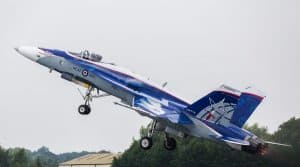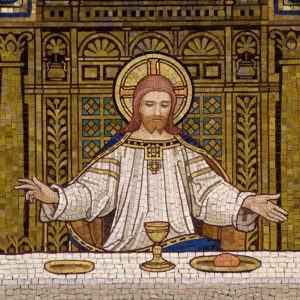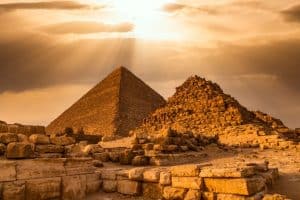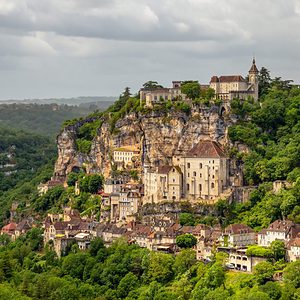The Nazca Lines in Peru, are wondrous symbols drawn centuries ago in a desert area of over 500 km2 between Nazca and Palpa. Dozens of animal figures, hundreds of geometric shapes, and thousands of lines have been preserved in the desert sands of Peru. This is because wind and rain are scarce; the plateau is one of the driest places on earth with an average temperature of 25 C.
Nazca
Somewhere in western Peru, not so far from the coast, is the town of Nazca. It is an unsightly place; there is virtually nothing to do, and the most exciting place near the village is the airport. Cessnas take off in short succession with about five interested people. In a flight of about 30 minutes, one can become acquainted with one of the world’s strangest phenomena: the Nazca lines in Peru.

How are the Nazca Lines made?
The desert consists of a brown, stony layer with a lighter layer underneath. In ancient times, the dark layer was brushed or scratched away so that the light layer appeared. This created drawings (pictographs) and lines. Then, from the dark sand, people raised the edges along the lines. This increased the contrast and made it possible to clearly distinguish the light lines. Thanks to the bone-dry, windless climate, the lines can still be seen today.
The number of lines is impressive. They crisscross an area of 500 km2. There are hundreds of lines and dozens of figures, of which the spider, the monkey, and the hummingbird are perhaps the best known.
The discovery of the Nazca Lines
Because the lines were barely visible from the ground, it took until the 1930s before the Nazca lines attracted serious attention. Around that time, pilots started flying commercial planes over Peru. Granted, earlier surveys dated back as early as 1926, but they really only included the straight lines. They were conveniently called Incatrails and were believed to be long forgotten paths along which the Incas held processions.
In 1941, the lines were “rediscovered” by Paul Kosok. He discovered that one of the lines was brightly illuminated by the sun on the winter solstice of June 21 that year. He immediately drew the conclusion that the lines must represent an astronomical calendar, a thought adopted by his then assistant Maria Reiche.

Who was Maria Reiche?
Maria Reiche was born in 1903 in Dresden. In 1932 she went to Peru, where she became a governess to a family in Cuzco. When she wanted to return to Germany after two years, she was persuaded by friends to stay in Lima. She was asked to translate scientific work.
In Lima she met Dr. Paul Kosok, an encounter that changed her life. She was introduced to the Nazca lines through him and would spend the rest of her life passionately researching the origins and meaning of these lines.
If you read about the Nazca lines, you will undoubtedly come across her name. From her humble cottage in the pampas, she undertook the task of conserving and guarding the lines.
Thanks to her efforts, she managed to ensure that the area was protected. People are not allowed to walk across it, and the lines can be viewed from the ground only from an observation tower beside the road.
Thanks to Reiche’s efforts, the Nazca lines became a world-renowned landmark, which has since been studied by numerous experts. Studies of their age, conducted thanks to the discovery of wooden poles at some points, showed that they were made about 2,000 years ago, between 500 B.C. and 500 A.D.

Just before her death, Maria Reiche confided her final thoughts in a documentary that aired on the Discovery Channel. You saw an old woman with oversized glasses sitting in a chair. She was suffering from cancer and did not have very long to live.
Maria Reiche, marked by a lifelong obsession, had to admit that after years of researching the meaning of the lines, she had not made much progress. The secret of the Nazca lines was still as mysterious as on the day she first arrived at Nazca. Yet she managed to unravel the greatest mystery. The mystery of our existence. Her last words in the documentary were:
There is no world anymore
There is an existence and a strong vibration,
It is not seeing only
It is a combination of everything that is there
You do not need to run to get to a certain place,
You just fly like an angel
It is like an electrical explosion…
The purpose of the Nazca lines
The meaning of the Nazca lines is still not known. Below I offer some suggestions, but as far as I am concerned, the real explanation has yet to be found.
Nazca lines as landing strips for UFOs
Erich Dänniker believed they were landings strips for UFOs. One of the images was even identified by him as a waving astronaut. The images would be visible from space, attracting visitors from other planets.
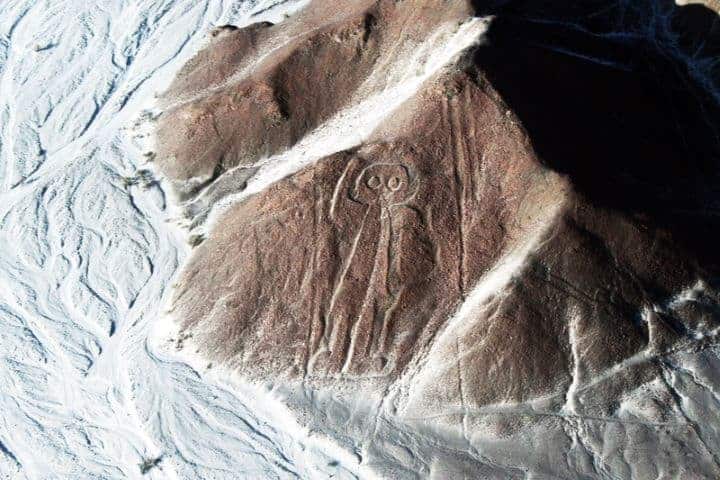
I must admit that his book inspired me to visit the Nazca lines. Not so much because I agreed with his theory, but because I had become curious about these huge pictographs. My conclusion was that the endless lines did resemble runways, but the fact that they crisscrossed each other immediately disproved that theory. UFOs would hopelessly bump into each other on the ground! The lines had to have another explanation.
When I actually saw the dimensions of the lines, the feeling came over me that this was something we could not comprehend.
The 100-foot-long astronaut that von Dänniker wrote about, waved, as if he were greeting us after a distant journey. But it could also be an image of an owl or a human being. Most of the images are recognizable, but not faithfully depicted. They are somewhat reminiscent of cartoon characters.

I first heard of the Nazca Lines when I read this book by Von Däniken. In one of his first books Chariots of the Gods, he described the Nazca Lines as landing sites for UFOs. I remember that the book had interesting images and how impressed I was by the lines. Probably the idea of visiting the Nazca Lines was born at that time.
Nazca lines, picto's for the Gods
Assuming that the Nazca lines were not made for fun, it is reasonable to assume that they are meant for the world of the gods. This theory is beginning to gain ground. The figures are symbols. The spider represents water and the hummingbird represents fertility.
Sacrificial sites decorated with shells have been found in the ground around the lines. All these symbols are part of a bigger picture, which can really only be grasped if you could comprehend the total culture of these Nazca Indians.
Most of the figures consist of a single line that never crosses itself. This could be the path of a ritual maze, more or less like the Labyrinth at Chartres. If that was the case, then when the Nazca people walked along the line, they might have felt that they were absorbing the essence of the drawing. This idea was first suggested in 1975 by Alan Sawyer.
Nazca's sacred landscape
Persin Clarkson suggests in 1985 that there is a relationship between the lines and the irrigation systems in the area. She refers back to the 1926 study, where the lines were interpreted as ancient roads (sacred Inca trails).
She also establishes a relationship with the ceques in Cusco. These are lines that lead from the center of Cusco to special places in the area. These special places can be springs, erected stones, temples, special hills, etc.
There is reference to a sacred landscape in the area around Cusco. The natural sanctuary has been enhanced, as it were, by human intervention. Perhaps this also applies to Nazca.
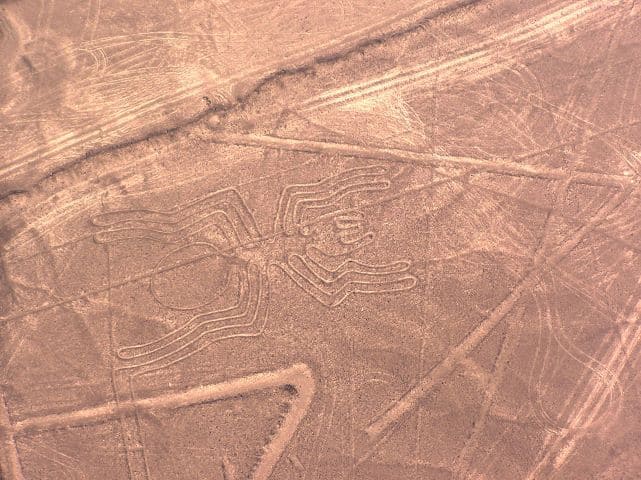
Nazca lines: an astronomical calendar
The debate over the astronomical significance of the Nasca lines (as assumed by Maria Reiche) is now controversial. Recent research found that a number of individual straight lines aligned with the equinox and seven randomly chosen bright stars. However, the number of these hits do not justify the theory that the Nazca lines is an astronomical calendar system. On the other hand, more research is needed to completely rule out this theory.
The Nazca lines were designed by hallucinatory Shamans
A video, shown at the little airport in Nazca, suggests shamans saw the Nazca images under the influence of hallucinogens. The pictographs and lines are said to be inspired by what the shamans saw under influence. Unfortunately, I have not been able to find this video anywhere, but I did find a 1980 scientific treatise on the relationship between hallucinogens and Nazca ceramics (source).

Other thoughts about the Nazca Lines
The Indians responsible for the Nazca lines also built the underground aqueducts (Puquois) that still supply the region with water in the 21st century. They were an intelligent and developed race of people, and when you fly over the geoglyphs in an airplane, you can’t help but admire their ingenuity.
And yet the use of geoglyphs is not unique.
In Chile, geoglyphs have been found in the Atacama Desert. You have the Great Serpent Mount in Ohio (USA) and Blythe Intaglios in California. You could travel to England to see the Cerne Abbas Giant or the Uffington White Horse. In short, the idea is applied in different continents and in different periods.
Actually, contemporary crop circles are also examples of icons best viewed from the air. If you follow this link, you can see how we examined crop circles some years ago.
Flying over the Nazca Lines...

If you go to Peru on your own and want to fly over the Nazca lines, you can arrange this hassle-free through “GetyourGuide.” You have several options. You can leave in Lima for organized day tour with a visit to the desert, or you can leave from your hotel in Nazca.
The advantage of GetyourGuide is that you know in advance what it costs and you don’t have to worry about being ripped off.
Should you want to arrange it all by yourself, you can of course go to the tourist information in Nazca or to the airport.
A few tips before you fly over the Nazca lines:
- Take a travel pill beforehand. Many people get nauseous during the plane trip.
- Fly as early as possible. That way you have the best chance of leaving on time and the light is optimal for seeing the lines.
- Don’t forget your passport! Even if it is a domestic flight, you must have a passport with you.
- Bring as little as possible, so you don’t have to watch your stuff and you can see as much as possible. You don’t need super-sized lenses to take nice pictures.



